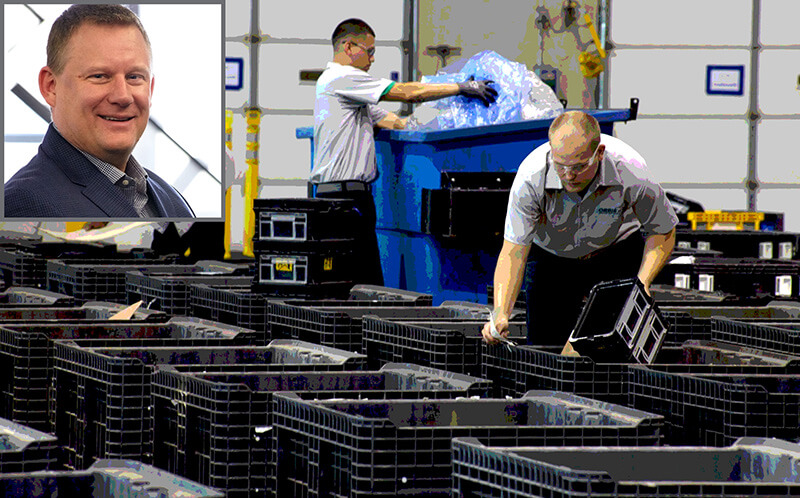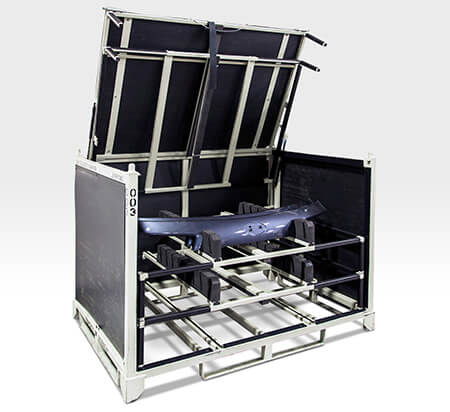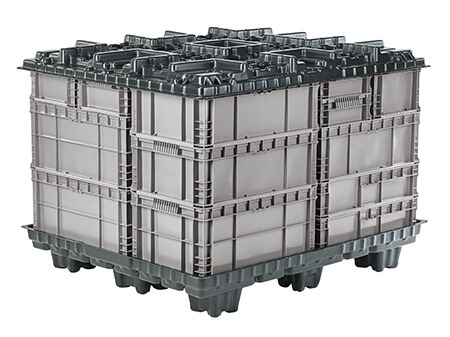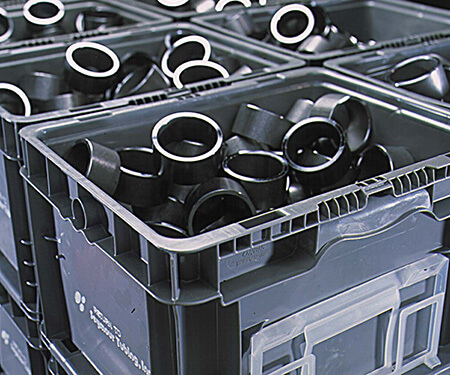 What does Orbis see as the main problem in providing accurate data on where a container is, whether empty or full, and what is it doing to solve some of these problems for its automotive customers?In the automotive industry, one of the biggest obstacles is standardisation. Toyota puts identification on its packaging [that is] different to what Ford does, and different to what GM does, for example, [but] everybody wants supply chain visibility and everyone has the same supplier. So the supplier of parts to GM is probably also a supplier to Mercedes and BMW and FCA. The supply chain for the tier suppliers is similar, but each OEM has their own packaging and logistics requirements.
What does Orbis see as the main problem in providing accurate data on where a container is, whether empty or full, and what is it doing to solve some of these problems for its automotive customers?In the automotive industry, one of the biggest obstacles is standardisation. Toyota puts identification on its packaging [that is] different to what Ford does, and different to what GM does, for example, [but] everybody wants supply chain visibility and everyone has the same supplier. So the supplier of parts to GM is probably also a supplier to Mercedes and BMW and FCA. The supply chain for the tier suppliers is similar, but each OEM has their own packaging and logistics requirements.
To us, the opportunity is around standardisation [and] Orbis is sitting on an industry group – the AIAG [Automotive Industry Action Group]. We are trying to figure out how we standardise that visibility throughout the system because you can’t just have it the way that GM or Toyota is going to do it; they are not separate supply chains – they are connected. We want to ensure that we are helping to push that standardisation but also that our packaging is flexible enough to meet the needs of whatever is decided. We want to make sure that we don’t pigeon-hole ourselves into a situation where we can’t be flexible because we all know that technology is changing and evolving.
You don’t want a whole supply chain system where you have packaging that can only do this and it can’t evolve next year or five years down the road.
Is an industry standard on size important and, if so, what is Orbis doing to achieve it? What are the benefits of greater standardisation?We are promoting vehicle systems expertise. So, how you package a steering wheel or a radio will be different, but we want to make sure that we are getting the best. A steering wheel is a steering wheel. They are all slightly different but how you package them should be similar. We look at standardisation focused on a vehicle system. To try and say that there is one packaging [standard] for everything to fit into is not realistic but our goal is to move forward with a vehicle systems expertise and understand the trends that are happening. For example, wire harnesses in cars are becoming bigger and that means the packaging in the supply chain has to change. Really, for us, it is focusing on vehicle systems and trying to be an expert on those. That is the best way to get standardised solutions.
"To try and say that there is one packaging [standard] for everything to fit into is not realistic but our goal is to move forward with a vehicle systems expertise and understand the trends that are happening" - Scott Krebs, Orbis
Do you see that changing as in-vehicle technology evolves and cars become more standardised in the new mobility future?To give a specific example, what we are trying to do now – and there are some OEMs that are working with us – is to say, ‘OK, we want to look out at the next three models that you are going to launch and we want to look at the steering wheels’. Each one will be slightly different but how do we come up with packaging that works with these next three, so that we don’t have all this packaging just for one and then have to change it again for the next model?
It is more flexible to deal with a higher level of SKUs [stock-keeping units] but a lower inventory level. Part of that is [about] having flexible dunnage to do that. You might stick with a standard footprint of containers that make sense in the logistics side of things. Trucks aren’t changing, so we have a certain footprint that we want to work on and come up with more flexible dunnage systems that can deal with the multiple different SKUs that are coming.
Are manufacturers and suppliers in the automotive sector their own worst enemies (and yours) when it comes to managing packaging assets and helping to maintain visibility?It comes down to who has their skin in the game. There are different models: one in which the OEM owns the packaging, or the tier supplier group really owns the packaging but gets it back in the piece price. There are models where pooling comes into play. Each one has its positives and negatives. I think that just understanding those differences and highlighting the positives is what needs to happen.
Usually whoever has invested in or is paying for the packaging and the visibility is the one that needs to drive the decisions and that is where we need to work with the tier suppliers and OEMs, or the pooling companies. They all have their positives and negatives and it is really just working with each one of them.

Where we run into some challenges is where the tier supplier purchases some of the packaging and they get reimbursed by the OEM: if the OEM is not treating the packaging right and they kick it back to the supplier and tell them to take care of it, you have to get involved in whether anyone is making sure that packaging is in good working order.
How do you ensure that the right packaging or container is available when it is needed? What can you do with the OEMs to promote cross-sharing of containers?Really, what all that comes down to is whether someone is interested in pooling. The optimal situation with pooling is that everybody is all-in and there is a common standardised package, and everybody is using it and standardising on it. We have found out that this is not necessarily the reality.
In North America, people didn’t really start at ground roots with that model and it is hard to get it into it because it is an all-or-nothing situation. You can’t just say you will grab this or that person; it is hard to sustain from an economic standpoint. So for us, how to get the right packaging and availability is down to investing in the quality of the packaging, which is what we do, and making sure it is in good working order for as long as possible. That is our part and then we roll in services to give them visibility over it.
We also promote tracking the packaging itself, because within an organisation you can get investments and capital spending but to support things, you have to have data to prove it. A company like John Deere has historically done a good job around that. They have been tracking their products for years and when they see damage or loss on products, they can come back with data and back to management, and say ‘hey, next year for planning purposes, I need this many millions of dollars for packaging – and here is the proof’. The alternative is that they have to go expendable, which is more expensive.
At a basic level, just tracking the packaging will help them sustain that investment, which is a good thing. And when you get to the next level, which is track and trace, then you are trying to figure out how you are tracking the commodity itself.
What can the latest technology, such as industry 4.0 technology, do to improve container management generally and what are some of the latest systems Orbis is exploring that apply to the automotive industry?Industry 4.0 to us is really using technology to automate things and do things smarter, including predicting things that are going to be happening in the future. We do it around our processes, how we make our products and how we automate things to support higher global quality, to make things more efficiently. The other thing we are doing is building more pieces of data and software that we can connect to our customers, to help us forecast more appropriately.
[mpu_ad]One thing we are doing is an initiative called Tiger Teams. It is project management within the model launch. Our Tiger Teams sit down with the OEM at the very beginning, before the vehicle is even realised by many months, and we actually go through a project management programme with them; we set out the goals and execute on that. We keep ourselves up with what the current state is, what the issues are, and we track those. Then we launch the programme and give them what they need. Once the vehicle is launched in the market, we come back and do an audit and we look at lessons learned. One of the things we've learned is that we can take all that information and roll that into the next model build.
Orbis has a range of products that are resuable and recyclable, but how is it managing the movement of packaged goods in a way supports greater sustainability?Sustainability is one of our passions. Any time that you have an expendable product, we try to get people into returnables. There is an economic justification there that needs to be made but more companies are looking at the bigger picture because there are more marketing dollars that are penetrating through the supply chain.
Disposable packaging is still a multi-billion dollar market. What can be done from an environmental and economic point of view to mitigate the impact of disposable packaging as a necessary but costly waste?We are looking to see whether we could use the benefits from the high-volume OEM side to influence the automotive service sector and dealers. We have been working on that and there are some challenges there, but we are looking at whether we can take the value of returnable packaging and use it within a different supply chain within the automotive industry.
There is high volume on the OEM side, obviously. When you get to the dealer network it is lower volume, but there are things we can then employ, from our learnings in the retail segment, to help automotive dealers.
At what point in the design of a component do you think packaging engineers need to get involved, and why?At a very high level, as soon as possible. There is a lot of discussion around how design can influence packaging and the efficiency of the supply chain. A designer doesn’t know what they don’t know about supply chain, so if they have a bracket that could be moved and it doesn’t change the overall build of that part then that can influence a lot of things in the supply chain.
"Sustainability is one of our passions. Any time that you have an expendable product, we try to get people into returnables. There is an economic justification there that needs to be made but more companies are looking at the bigger picture because there are more marketing dollars that are penetrating through the supply chain" - Scott Krebs, Orbis
In the Tiger Teams, our answer to that is having discussions up front. When I talked about looking at the next three steering wheels, that intimate relationship with the supplier and their designers up front helps us bring in even more value. Once things are established, there are certain things that are held constant and we can only bring so much value. The more we can influence that or understand what is happening, the more value we can bring. I would say that today, there is definitely improvement on getting higher-level involvement in when the parts are being designed.
The last two company acquisitions Orbis made – Hinkle and Response Packaging – were of dunnage suppliers. Why is this a focus of your M&A activity at the moment?The reason is that this is a growing part of our business. We are looking to create a leadership position [and] we want to bring more value for our customers. By growing this segment of the business, we have better capabilities and get better service to our customers. We are going to have more flexibility and we will have more locations to service our customers. Also we are going to be able to be more collaborative and more unbiased in our solutions.
Recent acquisitions have allowed us to be a direct supplier within the metal container side of things. So, when someone comes to us, we don’t have to say ‘we only do it in plastic’. We can be a more unbiased, higher-value supplier by having multiple solutions.
What about the influence of the transport mode you are loading containers onto and the changes to this part of the sector?Right now, I would say this is more basic. Trucks are trucks, but I see a potential trend coming where automotive is going to have to become more efficient around the handling practices. Having automated systems that load and unload trucks, and the touchpoints and how those work with the packaging – that is important. We must make sure that we have a product that is sustainable, has good quality, works, but has the flexibility to allow the efficiency to happen. That is industry 4.0 as well.
 Orbis provides one of the largest ranges of bulk containers in the industry
Orbis provides one of the largest ranges of bulk containers in the industryWhere people are driving forklift trucks all the time, they used to go to the assembly line. Now there are tuggers and trains that do that, and the forklift trucks are more at the loading and unloading sites. We see a potential trend where that is going to be automated and that is a way that will influence the handling of the products that are going into the trucks themselves.
The [delivery] trucks will stay similar in nature in the sizing of them. Right now a very big pain point is driver availability and timings. The future state is where you have a driver in the cab and other pieces of truck behind it [vehicle platooning] that break away at some point, and others take over. That is where we see a lot of advancement – but not on the packaging side.
Retail and automotive are different sectors. Are there any things that could be transferred?Orbis does a lot with industrial and automotive, and then we have a separate division focused on the beverage and food companies and the major retailers. We work with Amazon and Walmart and the Home Depots of the world.
For me, the main difference between the retail and automotive supply chains is that the automotive side is more complex in (and the challenges are more around) execution, whereas on the retail side of things, it is more complex in the planning side. It is harder from a planning point of view.
In retail, things are changing so quickly. If you have stockouts or your forecasts are out or there are overruns, trends affect the retail side a lot quicker. The planning on the retail side is harder.
On the automotive side, there are a lot of heavy design elements. Tenders are left variable for changes there. There is a lot of complexity and it is good from a planning standpoint but the challenges on the automotive side are in the complexity of the execution – the just-in-time on assembly. So the detail in the communication between the OEM and the suppliers is good, but the automotive industry is becoming more complex and the end consumer is driving a lot of the trend; that is requiring the supply chain to become more dynamic in nature.
A cross-over bridge is the service parts industry and how we might use some of our best practices [in retail] to work with [automotive service parts].
The other thing is standardisation. It is a big thing we continue to push and where you get retail supply chains working together more. How do we take that value to the OEMs and have them collaborate as well? There is lots in there.
Mobility is a big subject in retail now and I see that automotive does a very good job at the moment on the mobility side and automating processes. Those are the more significant pieces: standardisation, mobility and overall supply chain visibility.
On the retail side of things, you tend to get more visibility than in automotive. There is more tracking of things because of issues with food, and things wrapped around that which are higher technical issues than automotive is wrestling with.
 Orbis made two significant purchases in 2018. Its buyout of Response Packaging in April was followed the next month by the acquisition of Hinkle Manufacturing.
Orbis made two significant purchases in 2018. Its buyout of Response Packaging in April was followed the next month by the acquisition of Hinkle Manufacturing.
Response Packaging designs, prototypes and manufactures reusable custom dunnage and fabricated steel rack containers, and serves the automotive and industrial markets. As part of the deal Orbis has the company’s design, testing and manufacturing facilities in Piedmont, and Greenville, South Carolina; Auburn Hills, Michigan; and León, Mexico.
Response Packaging engineers custom dunnage designed for part protection and specialises in fabricated steel rack and dunnage systems for the transport of vehicle components in the supply chain.
“Orbis has been pursuing a strategy to expand its custom business to serve customers with a broader portfolio of solutions,” said Jim Kotek, president of Menasha Corporation, parent company of Orbis. “The acquisition of Response Packaging supports this objective by adding complementary capabilities and establishing a manufacturing presence in the south-east, and expanded capabilities to meet our customers’ needs in Mexico.”
The takeover of Hinkle, meanwhile, builds on Orbis’ services for the automotive industry. Hinkle provides the automotive sector with custom dunnage designed for parts protection. Hinkle also operates a thermoforming plant in Dearborn, Michigan, where it produces trays and other plastic components.
“Our commitment to providing unmatched products and services includes ensuring that our customers have the best options for their reusable packaging needs,” said Bill Ash, president of Orbis Corporation. “Hinkle Manufacturing and our recent acquisition of Response Packaging will strengthen our custom solutions offerings.”


























![Global[1]](https://d3n5uof8vony13.cloudfront.net/Pictures/web/a/d/s/global1_726550.svgz)












